7 minute read
Women and sexual harassment in the workplace
08 Mar 2021

Article co-written with Aristotelis Alexopoulos, Director Applied Reseach and Innovation
Interesting data and fruitful conclusions, above other things, on the matter of women’s sexual harassment in the workplace emerged from the “Breaking the Glass Ceiling” research which was conducted by Alba Graduate Business School, The American College of Greece, and co-curated by the organization for the professional empowerment of women “Women on Top” – a Vodafone initiative.
The goal of the research was to investigate and record perceptions and experiences of two different, and —interactive in the modern work environment— groups: women themselves on one hand, and business executives on the other, in relation to the existence of gender discriminations in workplaces, work-life balance, skills-related issues, education and development, violence and sexual harassment in the workplace, and lastly, social stereotypes on gender. The research was conducted in July 2019, through a. two digital calendars (period of July 4-30, 2019), adapted to the two target populations —women and executives— and b. three focus groups (July 15, 17 and 18, 2019) with women participants (a) at early stages of their professional career (“women’s focus groups”; (b) women in a leadership position (“model focus groups”); and (c) Human Resource executives (business focus groups). The research design and the collection of quantitative, as much as qualitative data discouraged the recording of broader patterns on the perceptions of women and business executives, but also offered the opportunity to control and delve into separate topics.
The quantitative research of women yielded 299 actionable responses. The majority of participants was 30-49 years of age (76%), privately employed (60%) and graduate degree holders (55%). 44% were single while 41% married. Lastly, 48% had dependent family members (minor children, senior parents, disabled family members) while 52% didn’t. In the enterprises’ quantitative research, 107 actionable responses were collected. The majority of participants were women (93%), between 40-49 years of age (53%), middle or high-level managers (55%) and graduate-level (77%) executives. 43% of participants worked at a Human Resources Department, while 25% belonged to the General Management. A wide range of industries was represented, with a greater participation of the retail and wholesale industries, the manufacturing and telecommunications industries as well as the informatics industries. The focus groups comprised a total of 25 individuals, all women. The discussions were recorded with electronic devices (voice recordings). In total, 5 hours and 45 minutes of conversations were collected resulting in transcripted material of 48,452 words.
The participation of distinct groups of the women employees as well as the executives–“management” representatives, offered the opportunity of comparative evaluation of the perspectives of those two groups in a series of topics, among which sexual harassment and violence in the workplace. Of great interest is that there was a difference in the perceptions of women and business executives with respect to the frequency of sexual harassment, and with respect to the effectiveness of corporate policies against the phenomenon. Specifically, the image described by women is significantly more negative than that described by the business executives.
So, οn the main topic of whether the problem “exists” (personal experience – witnessing – recording) the first differentiations emerge. Notably, while the same women responded by 51.1% that “sometimes” or “frequently” they have witnessed occurrences of sexual harassment in the workplace, the percentage drops to –only 15.1%– in the business executives’ responses. The opposite findings emerge with respect to the “rare” observation of such phenomena: here the percentage of women’s responses drops to 24.7% while the percentage of executives rises to 50.9%. This picture is maintained also to the non-witnessing of such phenomena: while only 24.2% percent stated that they have never “witnessed” a case of sexual harassment in the workplace, this percentage increases by almost 10 percentage points (34%) in the business executives group.
Even more disconcerting is perhaps the difference in the percentage of responses between the personal experience and the recording of cases of sexual harassment in the workplace. So, while in total, 56.6% of female employees state that they have experienced cases of sexual harassment (“frequently”, “sometimes” and “rarely”), only 34% of business executives state that there have been similar cases according to their experience. There is a characteristic difference in the percentage of answers in the field “sometimes”: while 20.6% of women stated that they have “sometimes” experienced cases of sexual harassment, only 5.7% of executives state that they have “sometimes” recorded similar cases.
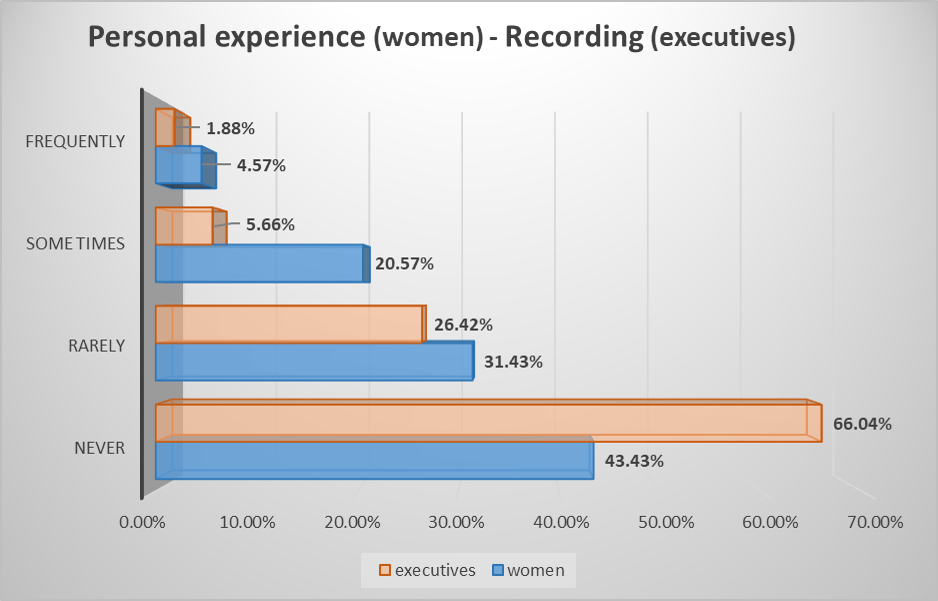
It is worth noting that there also exists a difference of perception in the two groups in relation to remaining forms of violence, within the workplace, as well as microaggressions. These are mainly about sexist/demeaning comments about the (non) professional manner/tone with which a female employee is addressed. Thus, while 92.2% women state that they have experienced being addressed in a non-professional manner (“rarely”, “sometimes” and “frequently”), only 75% have been recipients of demeaning/sexist comments, but only 64.2% of executives has noticed such cases. It is seen that, despite the difference in perception between women and executives on the matter of the frequency of microaggressions, percentages are alarmingly high in both groups.
Of interest are the opinions of women on the reporting of cases of sexual harassment. So, the majority (49.7%) would like to report it internally within the organization and fewer (42.5%) externally, to an independent body (i.e. the police, a judicial authority or the labor inspectorate. It is certainly encouraging that very few among the women who participated in the research believe that such cases should be hushed and never be reported (7.8%). However, when we enter the realm of consequences arising from such a report, things get complicated. So, the large majority thinks that such a development carries risks for their professional development (a percentage of 93.1% in the fields “sometimes” and “always”) will shake their collegiate relationships (92.6%), or even that it will put their safety in the workplace at risk (81%). This concern was also expressed in the focus group of the women-models with mentions to specific incidences.
“Perhaps she feared that there would be a cost against her. Her career was in an upward spiral. She didn’t give in though. But it caused her such an unpleasant feeling at work that she couldn’t handle it. A young woman remarkable in every respect.”
Although the majority of women believe that reporting an incident is likely or certain to be ignored (percentage “sometimes” and “always” 75.7%) they think that this is not going to happen, will be fairly examined (percentage of 77% in the fields “sometimes” and “always”) and will bring results (77.1%). Lastly, in this category of questions, the percentage of women who state that such reports “are better be avoided” (“sometimes” and “always”) amounts to 34.7%. The importance where the attitudes of men are concerned in reporting cases of sexual harassment was noted by a participant in the women’s focus group.
“I believe that it is much more resonant for a man to say ‘I would never accept this in the workplace’ than for a woman to speak up for herself. If the two can be combined, then this is the best.”
Concerning the corporate policies against violence and sexual harassment in the workplace, while 66% of executives report that they have implemented similar programs in their businesses (“fully” or “partly”), the experience of women is different: the majority (50.3%) mention that they have rarely seen the implementation of such programs, with 22% mentioning “sometimes” and “19.8” mentioning “never”. Only 7.9% of women state that they have encountered such policies “often”.
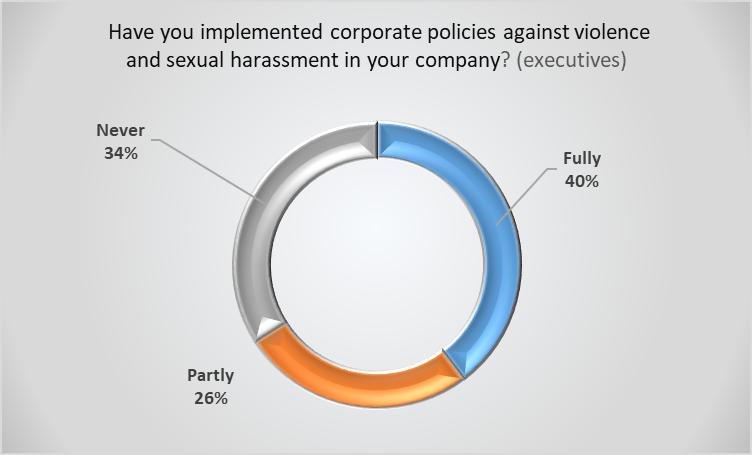
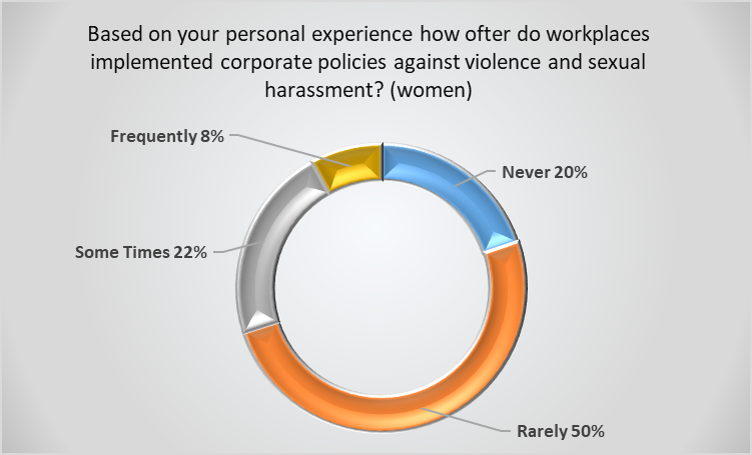
This differentiation appears more pronounced in the perceptions about “actual” implementation (in practice) and the effectiveness of such policies. Thus, while 48.5% of executives state that such policies are indeed implemented and 42.4% state that they are ineffective, the respective percentages drop at 3.1% (implementation) and 9% (effectiveness) in the responses of women employees. Conversely, only 2.9% of executives state that such policies are not implemented “at all” and 6.1% that they are not “at all” effective where they are implemented, while the respective percentages increase to 22.2% (implementation) and 21.2% (effectiveness) in the women’s responses.
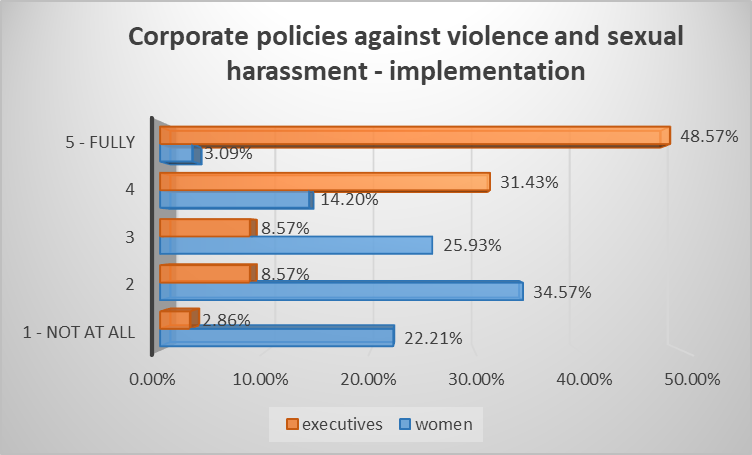
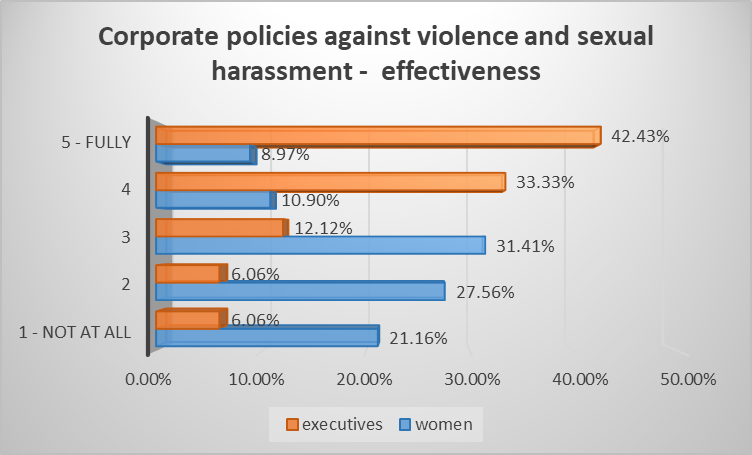
Lastly, with respect to corporate policies of prevention and battling of phenomena of sexual harassment and violence in the workplace, executives state that in their organizations these are primarily processes and mechanisms (reporting – incidence investigation/examination, accountability and allocation of responsibility) and less clear and measurable goals. A significant percentage (22.9%) admits that such policies only exist on paper and are not actually implemented. Concerning the businesses which do not have respective policies against violence and sexual harassment, only 5.6% of those who responded intend to pass such policies. 50% state that this is “likely” while 44.4% clearly state that this is not going to happen. Lastly, on the part of prevention, only 28.3% of executives state that they implement employee training programs for the prevention of violence and sexual harassment.
The research findings, as presented above, highlight a differentiation in the experiences and opinions of women employees and business executives on the matter of sexual harassment in the workplace. Although many of the elements of this reality still remain open to further and detailed examination, nevertheless, from the analysis so far, interesting ideas and suggestions emerge for the reversal of this problematic situation. It seems that joint activations that will address and include working women, as well as executive-representatives of business management in which they are working can contribute creatively in the development of common perceptions, methods of approach and analysis of reality, as well as mechanisms and activations of prevention as well as battling respective phenomena. For instance, common training programs and/or common work groups have been proven to contribute significantly to the sensitization (due to “human connection” and “empathy” which occurs among members of common groups) as well as to the development and successful application of solutions (through the feeling of “co-ownership” that they create). Especially at this point we must stress the crucial role of men, from whichever hierarchy or professional role they come from, for the success of respective initiatives). It will be a good start if we succeed to make clear (mentally and emotionally) to all, women and men, that safety at work is everyone’s right and that battling of phenomena of violence and sexual harassment is something we owe to ourselves, to the society in general and to future generations.





